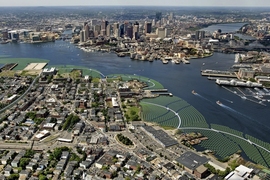The Sustainability DataPool, powered by the Office of Sustainability (MITOS), gives the MIT community the opportunity to understand data on important sustainability metrics like energy, water use, emissions, and recycling rates. While most visualizations share data from past events, the newest dashboard — the MIT Climate Resiliency Dashboard (MIT certificate required to view) — looks to potential future events in the form of flooding on campus. The dashboard is an essential planning tool for ongoing work to build a climate-resilient MIT, one that fulfills its mission in the face of impacts of climate change. It’s also a tool that highlights the importance of collaboration in devising sustainability solutions.
Development of the dashboard began in 2017 when the City of Cambridge, Massachusetts, released the first version of its FloodViewer. The viewer allowed users to map climate change threats from flooding in Cambridge. Scanning the map in the viewer, one could see all of Cambridge — except for MIT. At the time, the City of Cambridge did not have a full account of MIT’s stormwater drainage system, so the viewer was launched without it. That unmapped area served as a call to action for MITOS.
MITOS Assistant Director Brian Goldberg and MITOS Faculty Fellow and research scientist at the MIT Center for Global Change Science Ken Strzepek reached out to the Cambridge Community Development Department — with which MIT has long worked on climate action — and made a plan to populate the missing map information, working with the city to understand how to map MIT’s data to fit the FloodViewer model. Harmonizing MIT’s data with that of the city would complete the potential flooding picture for Cambridge, give MIT new insight on its own potential flooding threats, and enable a common climate change baseline for planning decisions about campus and city building and infrastructure projects. “We saw this as an opportunity to expand our understanding of our own threats on campus and to team with the city to explore how we could develop a common picture of climate change impacts,” says Strzepek.
From there, Strzepek, Goldberg, and a number of MITOS student fellows began work on what would become the Climate Resiliency Dashboard. MITOS partnered with the Department of Facilities; Center for Global Change Science; Office of Emergency Management; Office of Campus Planning; Department of Earth, Atmospheric and Planetary Sciences; Urban Risk Lab; and other members of the MIT Climate Resiliency Committee for assistance on data, design, and user testing. These partnerships helped create the most accurate picture of potential flooding impacts on campus by looking at topography, stormwater management systems, and past trends.
The beta version of the tool went live in November 2020 and functions much like the Cambridge FloodViewer: Projected flooding data is laid over a campus map of MIT, allowing users to zoom in on a portion of campus under a specific scenario — say, a 100-year storm occurring in 2030 — and see the projected potential peak rain or storm surge water depth at that location. The dashboard explains not only how these numbers were calculated, but what types of rain and storm surge events can cause them to happen. But the flood mapping is only part of the story. “Flooding itself isn’t necessarily a problem — it’s the potential of that flooding to interrupt MIT’s critical research, education, and campus operations,” explains Goldberg.
The dashboard is already informing new building designs, such as the MIT Schwarzman College of Computing, which is designed to be resilient to a 100-year flood event anticipated under a changed climate 50 years from today. “By enabling MIT to understand flood risk for new buildings, we can respond holistically to that risk and integrate flood mitigation strategies as part of the overarching design,” explains Randa Ghattas, senior sustainability project manager in the Department of Facilities. “This could include intentionally elevating buildings or a combination of gray- and green-infrastructure site-level strategies to mitigate flooding and support multiple benefits like stormwater management, urban heat island mitigation, and enhanced outdoor comfort.”
Information displayed in the dashboard is continually being refined as the science and engineering of flood risk modeling progress. Goldberg explains, "While the dashboard projects water depth next to campus buildings, we’re still testing methods for informing whether water will actually enter buildings via doorways, low windows, or ground-level air vents.”
Although the dashboard will always contain a certain level of uncertainty, the plan is to continue to evolve a more robust tool. “We called it the MIT Climate Resiliency Dashboard, and not the MIT Flood Viewer, because we plan to visualize more data related to climate resiliency, like extreme and prolonged heat events,” says Goldberg, noting that heat information is expected to be added in late 2021. “As the science advances, understanding heat impacts today and going forward will bring more of that into this dashboard.” Cambridge has already modeled some aspects of future heat risk and developed preparedness plans, allowing MIT to build upon the city’s heat risk modeling, communicate findings through the Climate Resiliency Dashboard, and anticipate how MIT can protect its community, research, academics, and operations from changes in heat over time.
This Climate Resiliency Dashboard joins many other data sets and visualizations available to the MIT community in the Sustainability DataPool — part of the fulfillment of Pillar E of MIT’s Plan for Action on Climate Change, which calls for using the campus as a test bed for change. “By testing these ideas on campus and sharing our data, findings, and planning frameworks, we’re not only supporting a more climate-resilient MIT, but also providing the tools for others to learn from us, solving these same challenges in their own communities and institutions,” says Goldberg.










